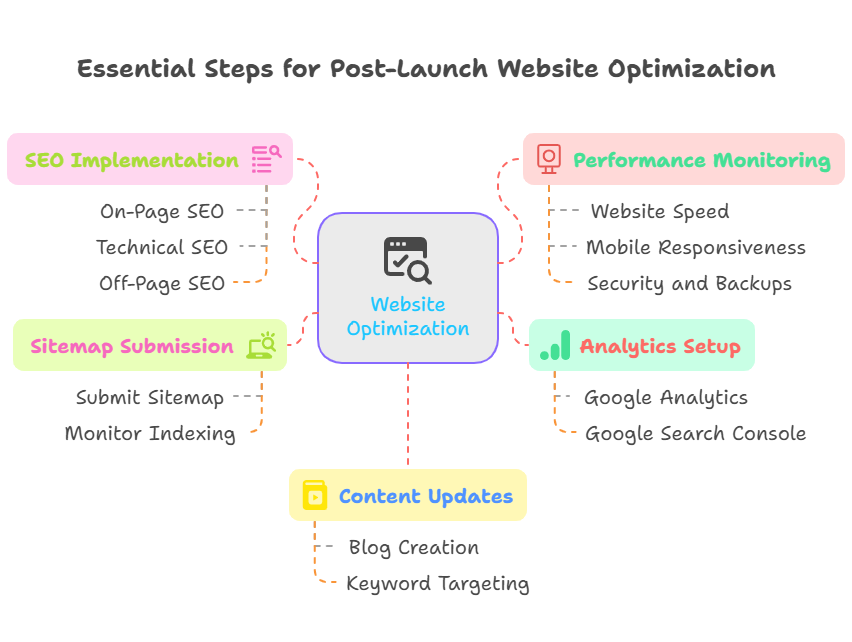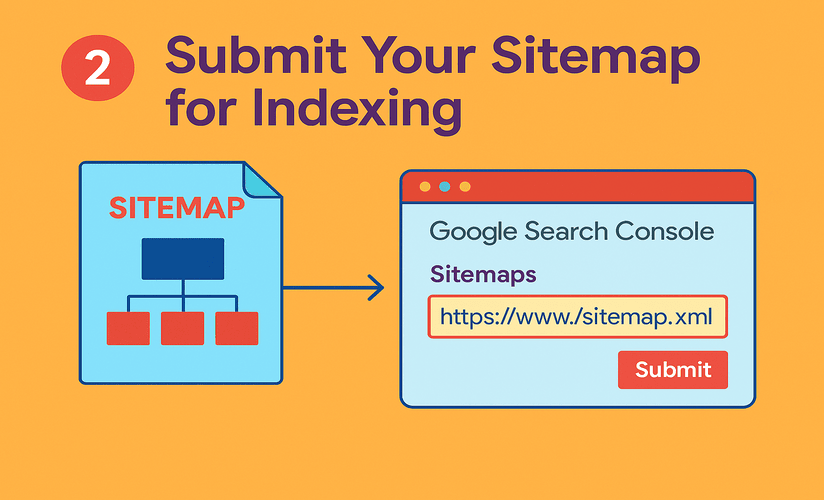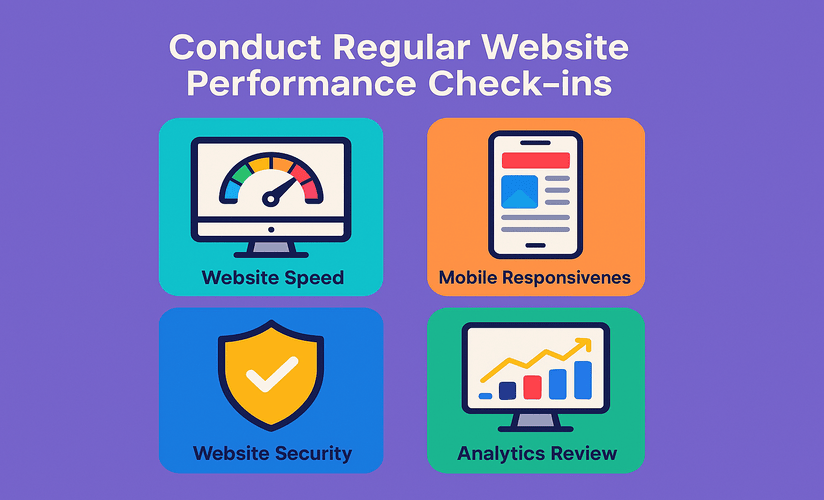You’ve put in the hard work—designing layouts, crafting content, polishing visuals, and perfecting the functionality. Hitting that “publish” button feels amazing (and it should!). But guess what? That’s not the finish line… it’s the starting point of something even more exciting.
Now it’s time to make your website work for you. Whether you’re offering custom software development, mobile app solutions, or CRM services, what you do next will determine how much impact your site really makes.
Let’s walk through 5 smart, essential steps to turn your freshly launched site into a lead-magnet and growth machine.

After launching your site, one of the most important technical setups is integrating analytics and monitoring tools. Launching a website without these tools is like flying blind. Every professional website design company or custom software development company in the USA would agree that data is essential for decision-making. These tools help you collect valuable insights about your visitors and how your website is performing, allowing you to make informed improvements over time.
Google Analytics is a free tool that gives you detailed information about the people who visit your website and how they interact with it. It helps you answer key questions such as:
To set it up, go to Google Analytics, create a new GA4 property, and add the tracking ID to the header of your website or use Google Tag Manager to do it more efficiently.
You can also set up event tracking to monitor actions like button clicks, video views, or downloads. This helps you better understand your users and improve your site design or marketing strategy accordingly.
While Google Analytics gives you behavioral data, Google Search Console focuses on your website’s presence in Google Search results.
It allows you to:
To set it up, visit Google Search Console, add your site as a property, and verify ownership. You can do this using a DNS verification, uploading an HTML file, or using a meta tag in your website’s header.
These tools are invaluable for any web design services in USA aiming to optimize for long-term traffic and conversions.
After your website is live, search engines need to find and index your pages to show them in search results. This doesn’t happen automatically, especially if your website is new or has very few inbound links.
Submitting a sitemap makes it easier and faster for search engines like Google to discover all the pages on your website.
A sitemap is an XML file that lists all the important pages you want search engines to index. Most modern content management systems like WordPress automatically generate a sitemap. You can usually find it at yourdomain.com/sitemap.xml.
Once you have your sitemap URL, go to Google Search Console and:
Submitting your sitemap ensures Google knows exactly which pages to crawl and helps avoid problems like pages being missed or not indexed at all. If you make significant changes to your website structure or content in the future, it's a good practice to re-submit your sitemap to speed up the re-indexing process.

After launching, one of the most effective strategies to keep your website fresh and search engine-friendly is by publishing content regularly. A blog or news section serves as a platform to publish new content, target new keywords, and engage with your audience.
Why is this important?
Search engines prioritize websites that are regularly updated with fresh, relevant content. A blog helps you expand your keyword strategy, showcase your expertise, and give value to your audience.
If your website remains static for months, search engines may consider it outdated or less relevant, which can hurt your rankings. On the other hand, publishing even one high-quality blog post every two weeks can help you rank for more long-tail keywords and increase traffic.
Here are a few blog ideas you can consider:
Make sure your blog posts are optimized for SEO by including relevant keywords, writing compelling titles, structuring content with proper headings, and adding internal links to other pages of your website. Use blogging as a platform to share insights into your process—whether it’s how your app developers near me in Kerala build Flutter apps or how your custom CRM developers design effective sales automation tools. A well-managed, SEO-optimized blog not only strengthens your brand but also positions you as a trusted and active player in the software development industry.
Publishing fresh content helps in two major ways: it improves organic search visibility and keeps users engaged by providing useful information.
Search Engine Optimization (SEO) is the backbone of long-term website success. Right after launching your website, you should focus on laying down a strong SEO foundation.
SEO helps your website rank higher in search engine results, allowing more people to find your business organically. It also improves the quality of traffic, as users actively searching for your services or products are more likely to convert.
This includes optimizing elements on each page to make them search-engine friendly. Here’s what you should do:
Search engines not only care about content but also about how your website performs. Here are some technical aspects you need to address:
This refers to actions taken outside of your website to improve its authority. For example:
Tracking your keyword rankings allows you to understand how well your SEO strategy is working. Use tools like:
Start by identifying 10 to 20 important keywords related to your business. Monitor how they perform over time and update your content strategy accordingly.
Your job isn’t over after setup. Websites need regular maintenance to ensure they remain functional, secure, and effective. Many website issues develop over time and can go unnoticed without routine check-ins.
Here’s what to monitor:
A slow website can cause users to leave quickly, increasing your bounce rate. Use tools like Google PageSpeed Insights or GTmetrix to analyze your site speed and get recommendations. Compress images, remove unnecessary plugins, and use caching techniques to boost load time.
With a majority of users browsing through mobile devices, your site must look and function well on phones and tablets. Regularly test your pages on multiple screen sizes to ensure readability and usability.
You can use tools like UptimeRobot or Pingdom to monitor if your site is down. Regularly check for 404 errors, broken links, or server issues that can negatively impact user experience and SEO.
Security should be an ongoing priority. Ensure your SSL certificate is valid, keep your platform and plugins up to date, and install a reliable security plugin to detect malware or suspicious activity.
Make sure you have automatic backups in place—preferably daily backups if you update content frequently. Backups should be stored in a secure location separate from your website hosting.
Use Google Analytics reports to check:
This information helps you improve weak areas and double down on what’s working.
Establish a routine schedule—monthly or quarterly—for performance reviews and updates. This keeps your website healthy and aligned with business goals.

Launching your website isn’t the finish line—it’s your first step into the digital world. A solid post-launch plan is essential to grow traffic, boost visibility, and reach your business goals.
Quick Recap:
These steps don’t need big budgets—just consistent effort. Think of your website as a living asset: update, monitor, and improve it to unlock real value.
Need help moving forward? Whether it's SEO, blogging, CRM development, or app support—our team has your back.
At KSoft Technologies, we build smart digital solutions designed for growth. Whether it’s a lightning-fast SSR website or an interactive mobile app, we deliver what your business needs.
Our Services:
Let’s turn your website into a growth engine.
🚀 Book a free consultation and let’s build something impactful!
